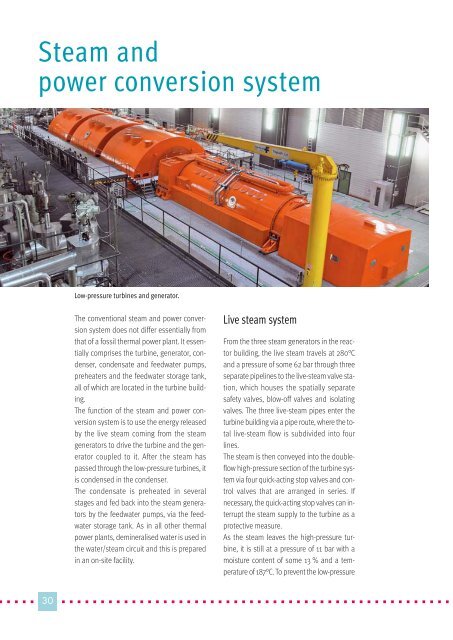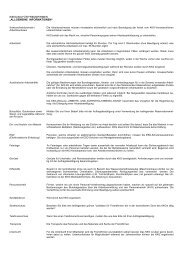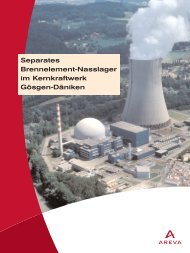Technology and Operation - Kernkraftwerk Gösgen
Technology and Operation - Kernkraftwerk Gösgen
Technology and Operation - Kernkraftwerk Gösgen
You also want an ePaper? Increase the reach of your titles
YUMPU automatically turns print PDFs into web optimized ePapers that Google loves.
Steam <strong>and</strong><br />
power conversion system<br />
Low-pressure turbines <strong>and</strong> generator.<br />
The conventional steam <strong>and</strong> power conversion<br />
system does not differ essentially from<br />
that of a fossil thermal power plant. It essentially<br />
comprises the turbine, generator, condenser,<br />
condensate <strong>and</strong> feedwater pumps,<br />
preheaters <strong>and</strong> the feedwater storage tank,<br />
all of which are located in the turbine building.<br />
The function of the steam <strong>and</strong> power conversion<br />
system is to use the energy released<br />
by the live steam coming from the steam<br />
generators to drive the turbine <strong>and</strong> the generator<br />
coupled to it. After the steam has<br />
passed through the low-pressure turbines, it<br />
is condensed in the condenser.<br />
The condensate is preheated in several<br />
stages <strong>and</strong> fed back into the steam generators<br />
by the feedwater pumps, via the feedwater<br />
storage tank. As in all other thermal<br />
power plants, demineralised water is used in<br />
the water/steam circuit <strong>and</strong> this is prepared<br />
in an on-site facility.<br />
Live steam system<br />
From the three steam generators in the reactor<br />
building, the live steam travels at 280°C<br />
<strong>and</strong> a pressure of some 62 bar through three<br />
separate pipelines to the live-steam valve station,<br />
which houses the spatially separate<br />
safety valves, blow-off valves <strong>and</strong> isolating<br />
valves. The three live-steam pipes enter the<br />
turbine building via a pipe route, where the total<br />
live-steam flow is subdivided into four<br />
lines.<br />
The steam is then conveyed into the doubleflow<br />
high-pressure section of the turbine system<br />
via four quick-acting stop valves <strong>and</strong> control<br />
valves that are arranged in series. If<br />
necessary, the quick-acting stop valves can interrupt<br />
the steam supply to the turbine as a<br />
protective measure.<br />
As the steam leaves the high-pressure turbine,<br />
it is still at a pressure of 11 bar with a<br />
moisture content of some 13 % <strong>and</strong> a temperature<br />
of 187°C. To prevent the low-pressure<br />
� � � � �30 � � � � � � � � � � � � � � � � � � � � � � � � � � � � � � � � � � � � � � � � � � � � � � � � � � � �




